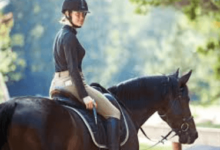The Silent Dialogue: How Riders Communicate with Their Horses in Dressage

Introduction
Dressage, often viewed as a ballet of equestrian sports, relies on a subtle yet profound communication between horse and rider. This invisible dialogue is central to performing the intricate movements that define the discipline. Understanding how riders communicate with their horses in dressage offers fascinating insights into this graceful and disciplined sport.
The Fundamentals of Horse-Rider Communication
- Aids: Communication in dressage primarily occurs through ‘aids,’ which are signals given by the rider to guide the horse. These include leg aids, seat aids, rein aids, and voice commands.
- Leg Aids: The rider’s legs can apply pressure at different points along the horse’s side to signal movements such as forward motion, lateral movements, or transitions between gaits.
- Seat Aids: The rider’s seat and weight distribution are crucial in directing the horse. A deep, centered seat can encourage collection, while a light seat may signal more forward movement.
- Rein Aids: Reins are used not only for steering but also for regulating the horse’s pace, encouraging bending, and maintaining contact. The subtlety and softness of rein aids are essential in dressage.
Training for Responsiveness and Understanding
- Consistency: Consistent use of aids is key in training the horse to respond correctly. This consistency helps the horse understand and anticipate the rider’s requests.
- Sensitivity: Dressage horses are trained to be sensitive to the slightest aids. This sensitivity allows for more refined communication and intricate movements.
- Trust and Bonding: Building a strong bond and trust between horse and rider enhances communication. Trust leads to a more willing and responsive horse.
The Role of Body Language and Non-Verbal Cues
- Body Language: The rider’s body language, including posture, balance, and movement, plays a significant role in communicating with the horse. Horses are adept at reading and responding to these non-verbal cues.
- Visualization and Energy: Advanced dressage riders often use visualization and focus their energy to communicate their intentions to the horse. This subtle form of communication can be powerful in guiding the horse.
The Importance of Voice Commands
- Voice Commands: While less common in competitive dressage, voice commands are used in training to reinforce other aids. The tone and pitch of the voice can convey different messages to the horse.
The Art of Listening
- Feedback from the Horse: Communication in dressage is a two-way street. Riders must be adept at ‘listening’ to their horses – understanding their responses, moods, and needs.
FAQs
- Q1: Can any horse be trained for dressage communication?
- A1: Yes, with proper training and patience, most horses can learn to communicate effectively for dressage. The key is in the consistency and quality of the training.
- Q2: How long does it take to develop effective communication with a dressage horse?
- A2: The time it takes to develop effective communication can vary widely. It depends on factors like the horse’s natural ability, the rider’s experience, and the consistency of training. Generally, it’s a gradual process that evolves over months or even years.
- Q3: Is it possible for a dressage rider to communicate with their horse without visible aids?
- A3: While it may seem like dressage riders communicate without visible aids, they are actually using very subtle, refined aids that are not easily noticeable to spectators. This level of subtlety is the result of advanced training and a deep bond between horse and rider.
Conclusion
The communication between a rider and their horse in dressage is a blend of art and science, requiring skill, patience, and a deep understanding of the horse’s psyche. This silent dialogue is what makes dressage a unique and captivating sport. It’s a testament to the incredible bond that can be formed between human and horse, where subtle cues lead to beautiful, expressive performances.

